Basic Football Rules for Beginners
Learn how to play football and stop feeling clueless watching from the sidelines.
When you say “football” in many parts of the world, most people think of soccer. So, around the globe, football as we know it is often referred to as “gridiron” or “American football.”
This summary of the basic American football rules will give you a good overview of the game and prepare you to enjoy watching your kids game or start a pick-up game of your own!
Football Rules
Object
Gridiron football is played by 2 teams with 11 players on the field at a time who attempt to score points by moving the ball down the field across the goal line or by kicking the ball between the upright goal posts. The team with the most points at the end of regulation time is the winner.
How to Play Football
Playing Area
The playing field is a rectangle 100 yards long and a little over 50 yards wide. There is a goal line at each end of the field leading into a 10-yard end zone, and at the back of the end zone there is an upright goal post.
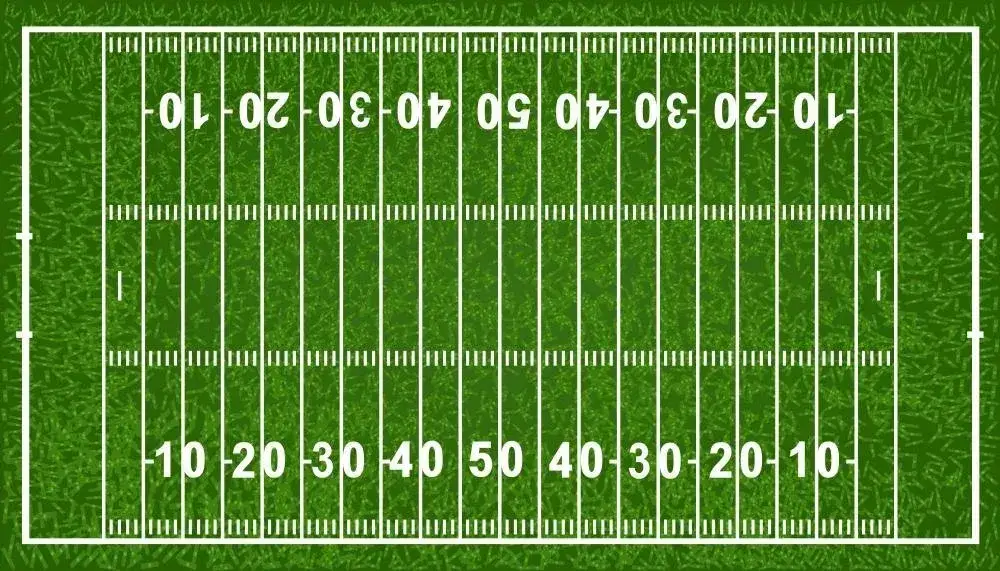
How to Play Football
Equipment
American football is a contact sport and probably requires more equipment than just about any other sport. Here’s a quick rundown of what players need:
- Helmet with a face mask
- Mouthguard
- Pads on the chest, shoulders, ribs, and kidneys
- Pants with pads to protect the groin area, thighs, and shins
- Turf shoes
- Jersey with numbers that indicate the player’s position
Jersey numbers:
- Quarterbacks, punters, placekickers: #1-19
- Running backs and defensive backs: #20-49
- Centers: #50-59 and #60-79
- Offensive guards and tackles: #60-79
- Wide receivers: #80-89 and #10-19
- Tight ends and H-backs: #80-89 and #40-49
- Defensive linemen: #90-99 and #50-79
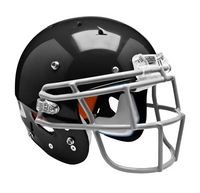
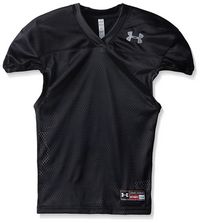
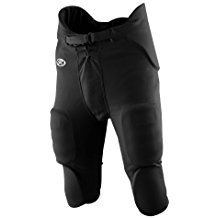
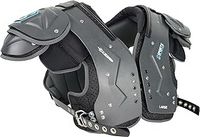

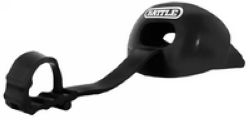
In addition to the protective uniform equipment for the players, you need a football and kicking tee. Footballs come in a variety of sizes. It’s important to select a ball that fits your players hands.
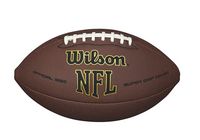
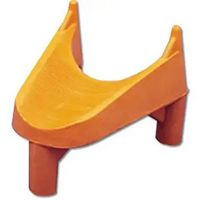
NFL Youth Football Uniforms
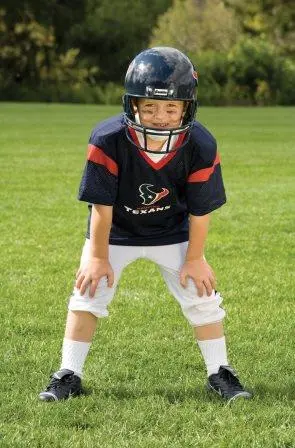
If your little one is an NFL fan, you can buy a youth-sized uniform for his favorite team! Keep in mind though, these uniforms and helmets are not meant to be used in competition. The helmet in particular does not provide the level of protection needed for body contact.

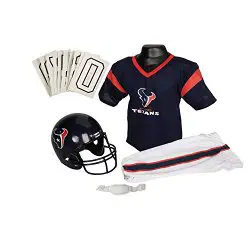
How to Play Football
Duration
College and pro football games last 60 minutes, and the game is divided into 4 quarters of 15 minutes each. High school games last 48 minutes and are divided into 12-minute quarters.
The clock runs unless the officials signal it must be stopped for incomplete passes or plays that go out of bounds. The officials also stop the clock when they need to measure the placement of the ball to see if the offense advanced it 10 yards.
Each team gets 3 time-outs per half.
If the game is tied at the end of 4 quarters, the game goes into overtime. Overtime is different depending on the level of play. For NFL games, the game goes into “sudden death.” A coin toss determines which team receives the ball, and the first team to score wins the game. If neither team scores at the end of 15 minutes, the game is declared a tie.
High school and college overtime periods give each team an equal opportunity to try and score. Both teams get possession of the ball on their opponent’s 25-yard line to score either a touchdown or a field goal. Their possession ends if they score, lose the ball on a fumble or interception, or fail to get a first down. Then the defense takes possession of the ball on their opponent’s 25-yard line. If the teams are still tied going into the 3rd overtime period, each team must attempt to score 2 extra points after each touchdown by running an offensive play to cross the end zone instead of kicking the ball through the uprights for a single point.
How to Play Football
Substitutions
Substitutes are only allowed to enter the game on a dead ball, and they must leave the field on their sideline.
How to Play Football
Starting Play
A coin is tossed prior to the opening kick-off to determine which team will kick off first and which goals teams will defend. Play begins with a kick off from the 35-yard line at the start of each half and after a score. After a safety, the ball is kicked off from the 20-yard line.
How to Play Football
Kick-Offs
A kick off is a free kick taken from the kicking team’s 30-yard line (40-yard line in high school). It may be taken in one of the following ways:
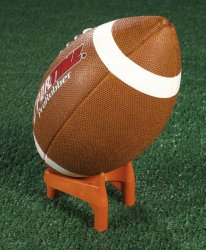
- It can be kicked off of a tee
- It can be drop kicked
- Another player can hold the ball for a place kick
During kick off, all players have to be inbounds. The kicking team, except for the kicker and the place kick holder, must be behind the ball. The opponent must be at least 10 yards away.
The ball must travel at least 10 yards. If the opposing team gains possession of the ball, they may advance the ball up the field by running with it. If the kicking team gets the ball, the ball is dead and it’s put in play from where it was recovered.
If the ball is kicked out of bounds (except for the end zone) before being touched by a member of the receiving team, it’s an illegal kick. The receiving team can have the kicking team kick it over again from a spot 5 yards closer to the kicking team’s goal or they may opt to take it at the spot it went out of bounds or 30 yards from the point of the kick.
How to Play Football
Changing Ends
Teams change goals at the end of the 1st and 3rd quarters, but the relative position of the ball on the field stays the same. For example, if the offensive team had the ball on the 30-yard line at the end of the 1st quarter, the ball is moved to the 30-yard line on the other end of the field and play resumes.
How to Play Football
Playing the Ball
- Players can kick, carry, and throw the ball to move it up the field
- A defender may knock down a pass that’s in the air
- If the player with the ball touches the ground with any part of his body except his hands or feet or if he goes out of bounds, he is called “down” and the ball is dead
- The offensive team has 25 seconds to put the ball into play on each down from the time the referee marks the spot of the ball
How to Play Football
Scrimmage Downs
Most of the football game takes place during plays, or downs, that begin at the line of scrimmage. The officials “spot” the ball before each down by placing it at a designated spot on the playing field.
A down is the period of time that begins when the center puts the ball into play until the ball becomes dead.
When a team has the ball, it has 4 downs to advance the ball 10 yards or score. Each time it moves the ball 10 yards down the field, it’s awarded a new set of 4 downs. If it fails to advance 10 yards, the ball is given to the other team at the point it became dead at the end of the 4th down.
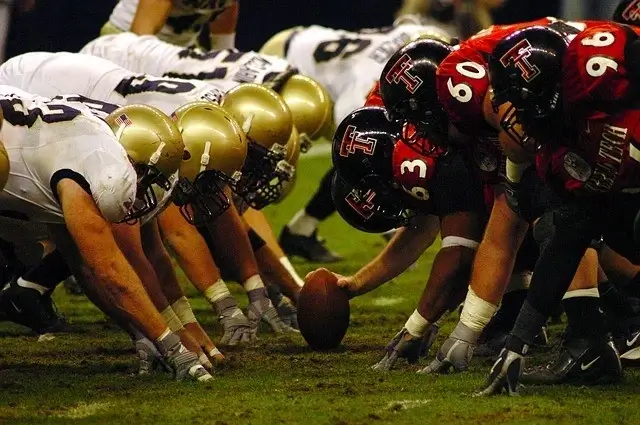
The line of scrimmage for each team is an imaginary line passing through the end of the football nearest to them, extending from sideline to sideline. The area between these lines, which is the length of the football, is the “neutral zone.”
Each team lines up at least 7 players on the line of scrimmage who stand on either side of the ball and are parallel to the goal line. These rest of the team, except the player receiving the snap (usually the quarterback), must be at least 1 yard behind the line of scrimmage.
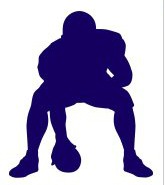
The snap is a backward pass through the legs of the center, who puts the ball into play. The snap must be one quick and continuous motion, and the snapper can’t move his feet or lift a hand until after the ball is snapped.
Other players have to stay still until the ball is snapped. No one is allowed to enter the neutral zone or move toward his opponent’s goal line at a snap. The snap must be to a player behind the line of scrimmage, unless it touches the ground.
How to Play Football
Fair Catch
After the ball has been kicked on a punt or kick-off, the player receiving the kick may signal a fair catch by raising one arm straight up in the air. By giving this signal, he has the right to catch the ball without being tackled by any member of the kicking team. The ball is dead at the spot of the catch. The receiver gives up the right to try and advance the ball up the field when he gives a fair catch signal.
How to Play Football
Playing the Ball
Football Rules
Backward Pass
A runner can make a backward pass at any time. A teammate may catch the pass or recover it if it hits the ground.
Fumble
If a player loses the ball and it leaves his hands, play continues no matter which team recovers it and whether or not it touches the ground.
Interception
An interception is a pass that’s caught by a defensive player while it’s still in the air. Possession of the ball belongs to the team that intercepted it.
How to Play Football
Forward Pass
The offensive team is allowed one forward pass during each play from the line of scrimmage, but the passer must be behind the line of scrimmage when releasing the ball. Any other forward pass is illegal.
Any of the defenders are eligible to intercept a forward pass, but the only offensive players that may catch a forward pass are those who are on the ends of the scrimmage line (except the center, guard, or tackle), or are standing at least 1 yard behind the line of scrimmage.
On any forward pass, the ball becomes dead when it:
- goes out of play
- hits the ground
- hits the goalpost
How to Play Football
Player Contact
Tackling
Tackling is when defensive players use their bodies to bring the player with the ball to the ground.
How to Play Football
Blocking
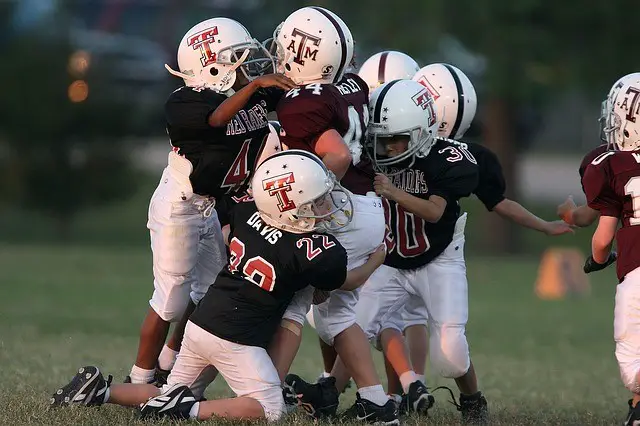
Defensive players use their bodies above the knees to block, or impede, the progress of the opponent. The blocker’s hands must be closed and kept inside the elbows. The arms may not be extended to push.
Blockers are not allowed to hold on to an opponent, and they can’t interfere with a pass receiver, a fair catch, a kicker, or a passer. Blocks can’t occur below the knees or in the back.
The runner with the ball can use his hands and arms to fend off a defender.
How to Play Football
Scrimmage Positions
All of the players line themselves up in formation on both sides of the line of scrimmage. There are very specific rules regarding how the players can line up.
- 7 players called “linemen” must line up directly on the scrimmage line
- 4 players called “backs” line up behind the line of the scrimmage
- Within this formation, there are only 6 players who are allowed to catch a forward pass during a play
Offensive players often line up on the scrimmage line in the following order:
- Left End (tight end, split end, or wide receiver)
- Left Tackle
- Left Guard
- Center
- Right Guard
- Right Tackle
- Right End
These are the offensive positions behind the line of scrimmage:
- Quarterback
- Running Backs (halfback, fullback)
The following positions are on the defensive side of the ball. These players can line up in a variety of ways:
- Linebackers
- Defensive Ends
- Defensive Tackles
- Defensive Backs
How to Play Football
Scoring
Touchdown = 6 points.
It occurs when a player carries the ball into the opponent’s end zone or catches a pass while in the end zone.

Extra Point = 1 point or 2 points (also known as PAT, point after touchdown).
After a team scores a touchdown, they get the opportunity to earn 1 extra point by kicking the ball through the uprights on the goal post. The ball is placed on the 2-yard line, and both teams line up on the scrimmage line for the kick. The distance of the extra point kick is 20 yards.
The scoring team may opt to go for 2 points instead. The ball is still placed at the 2-yard line, but instead of kicking it, they try to get it into the end zone again either by a run or pass. If they’re successful in crossing the goal line with the ball, they earn 2 extra points.
Field Goal = 3 points
On a team’s 4th down, if they don’t feel they will be able to advance the ball far enough for a 1st down and they feel they are within kicking range, they may attempt to kick a field goal from the line of scrimmage. If the ball goes through the goal post, they earn 3 points. If the kick is unsuccessful, the opposing team gets possession of the ball at the line of scrimmage or the 20-yard line (whichever is farther from the goal line).
Safety = 2 points
A safety is called when an offensive player is tackled with the ball in their own end zone. When this happens the defensive team is awarded 2 points, and the team that was scored on has to kick off from their 20-yard line.
How to Play Football
Dead Ball
A dead ball marks the end of a down. The ball becomes dead when:
- the ball carrier is downed
- there’s an incomplete pass
- the ball or ball carrier goes out of bounds
- a team scores
- a fair catch is signaled
- a member of the kicking team gets control of a punt to down it before the receiving team touches it
- a kicked ball stops moving
- a touchback occurs – when a kick lands in the end zone, it is spotted at the 20-yard line to begin play
How to Play Football
Out of Play
- When a ball is kicked out of bounds, it is placed at the point where it crossed the sideline. The only exception is for a free kick.
- When a free kick is kicked out of bounds, it is kicked again after moving the ball back 5 yards from the original spot of the kick.
- If a player with the ball runs out of bounds, the ball is placed at the inbounds lines in the center of the field at the point where he went out of bounds.
- If the ball is passed, kicked, or fumbled out of play behind the goal lines by the opposition, the defending team gets possession of the ball at the 20-yard line between the inbounds lines.
How to Play Football
Fouls & Penalties
Fouls
Players may not:
- hit with their fists
- kick or knee a player
- hit or kick a player below the knee
- tackle a player off the field
- tackle a player after the ball is dead
- grab a player’s face mask
- deliberately run into a kicker
- run into a passer after he has released the ball
Football Rules
Penalties
Here are some of the more common penalties included in the American football rules (there are many more):
- Blocking below the waist
- Block in the back – contacting a player without the ball in the back
- Clipping – contacting a player without the ball from behind and below the waist
- Delay of game
- Encroachment – a defensive player crossing the line of scrimmage before the ball is snapped
- Face mask – grabbing the face mask of a player in an attempt to tackle him
- False start – any player that moves after he has gotten set at the line of scrimmage before the ball is snapped
- Horse-collar tackle – grabbing the shoulder pads or jersey from behind and yanking the player to the ground
- Intentional grounding – a forward pass that is intentionally thrown incomplete so the passer avoids being tackled for a loss of yards
- Holding – grabbing or pulling a player without the ball
- Offside – a player is on the wrong side of the line of scrimmage when the ball is snapped
- Pass interference – making physical contact with a receiver to keep him from catching the ball
- Personal foul – any kind of conduct or safety-related rule infraction
- Roughing the kicker – tackling or running into the kicker
- Roughing the passer – tackling or hitting a passer after the pass has already been made
When rule violations are called, the following penalties may be assessed:
- Loss of down
- Loss of yards – 5, 10, or 15 yards
- Disqualification
If you’re looking to get a fun pick-up football game going, you will definitely need to modify the basic American football rules to fit the size of your group, your available equipment, and the size of your playing field. A very popular modified game is flag football.
A fun way for young kids to learn how to play football is through an NFL flag football league. For those kids ready to put on the pads, there are lots of organized youth football leagues in most cities throughout the U.S.

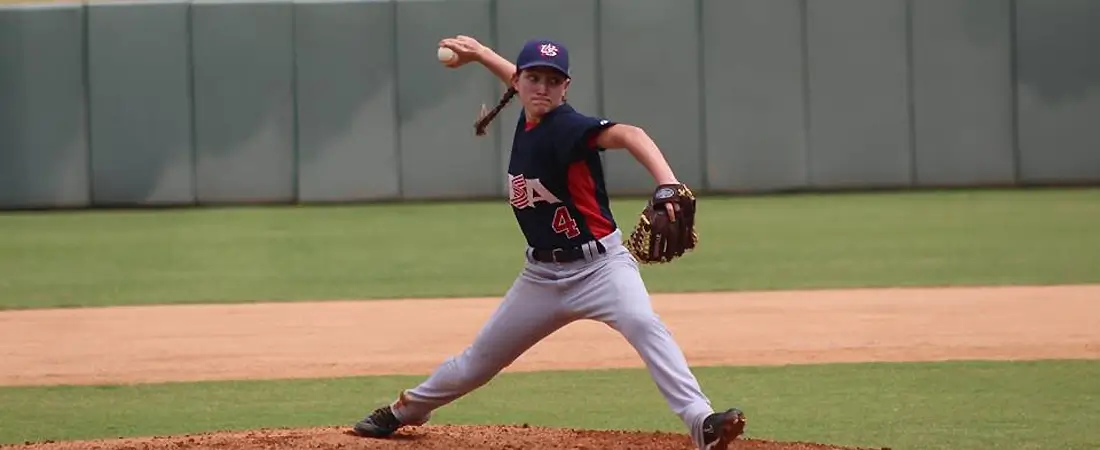
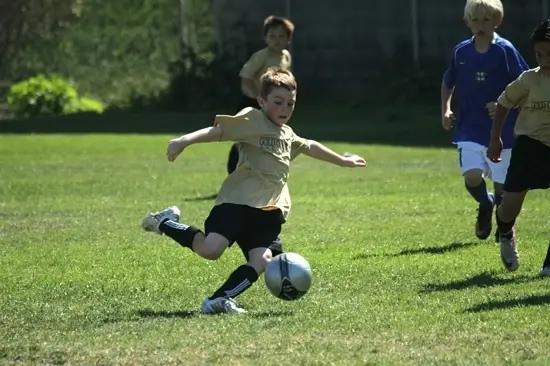
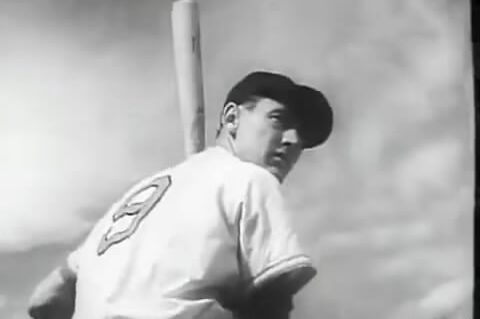
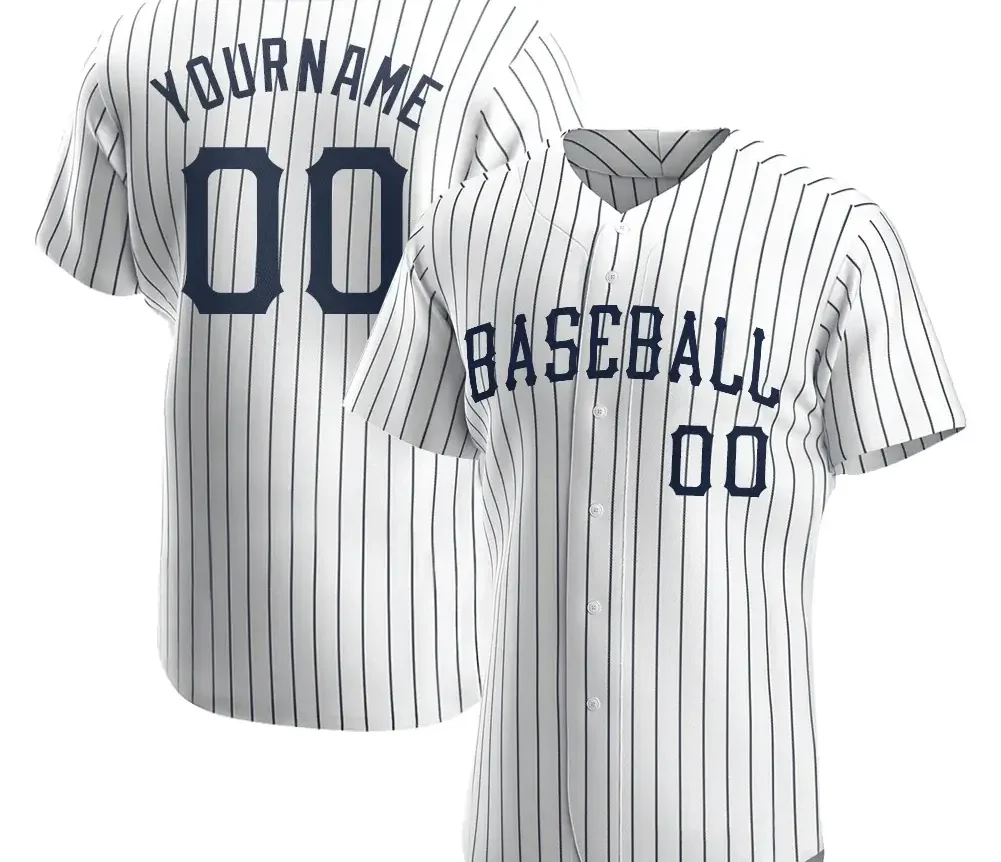
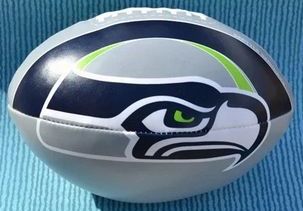
Leave a comment
Your email address will not be published. Required fields are marked *